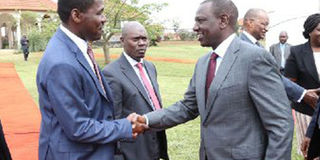It’s vital to look more closely at county-level politics as polls loom

Council of Governors Chair Peter Munya (left) receives Deputy President William Ruto for the Intergovernmental Budget and Economic Council meeting at Karen on September 28, 2016. Today, it is clear that governors and MCAs in particular enjoy considerable powers, resources and opportunities. PHOTO | DPPS
What you need to know:
- Many current senators and MPs, as well as aspiring politicians, have their eye on the local governorship.
- The idea of a DPC was born in the early 1990s in the cattle rustling-prone areas of northern Kenya.
It is generally accepted that county government seats are going to be more hotly contested in next year’s General Election than they were in 2013.
The reason is simple. In 2013, people did not know what powers and resources the new senators, governors, women’s representatives and members of the county assemblies (MCAs) would enjoy.
Today, it is clear that governors and MCAs in particular enjoy considerable powers, resources and opportunities.
As a result, many current senators and MPs, as well as aspiring politicians, have their eye on the local governorship.
Some politicians who contested parliamentary seats in 2013 are said to have their eye on the lucrative MCA positions.
It is also likely that some aspirants will seek to mobilise support by drawing upon old narratives of grievance and injustice against the local ‘other’ — be it the community across the county border, or a local minority or majority — while some may even opt to try and intimidate and threaten their opponents.
This combination of fierce competition and conflict insensitive tactics means the county government elections will likely increase inter-communal tension in some parts of the country.
However, at the moment, there is relatively little information about developments at this level.
For example, are counties such as Nakuru, Bungoma and Lamu going to negotiate another ‘shared democracy’, with seats divided between local ethnic groups?
What has happened to the gangs in Kisumu that were said to have been associated with rival groups of MCAs?
How are relations between local majorities and minorities in counties such as Mandera and Isiolo? And so the questions go on.
Limited discussion is then compounded by the fact that, in contrast to 2013, the infrastructure in place at the county level to monitor, report on, and respond to local tensions and conflict is relatively weak.
This is perhaps exemplified by the fortunes of the district peace committees (DPCs).
BEING CAUTIOUS
The idea of a DPC was born in the early 1990s in the cattle rustling-prone areas of northern Kenya.
Widely regarded as a community-based model that had been found to work, DPCs were rolled out across the country in 2008 following the post-election violence of 2007/2008.
Committees were meant to meet on a regular basis and to include local administrators, security personnel, women, the youth, elders and stakeholders such as religious leaders, local activists and business people.
The idea was that DPCs would provide a forum for administrators to map potential conflicts, and for information to flow up the chain of command so that early warning could prompt centrally organised and coordinated conflict mitigation and prevention efforts.
However, they were also meant to provide a space for community members to monitor and respond to early warnings, and, thus, help foster peace and reconciliation.
In practice, this approach suffered from a number of practical shortcomings.
Nevertheless, together with monitoring efforts by other international and national level actors such as the National Cohesion and Integration Commission, the DPCs contributed to a situation in the run-up to the 2013 elections, where people knew that their public statements might be monitored and recorded.
At the very least, this created a climate of invigilation that rendered the consequences of irresponsible speech uncertain and helped to curtail ethnic incitement.
With devolution, the DPCs were to be restructured.
However, while most counties have a county peace committee in place, reports suggest that most of these bodies are inactive due to a lack of funds.
THE BIGGER PICTURE
At the same time, local civil society organisations have had to rein in their peace-building work for similar reasons, while many local journalists report an unwillingness to report on issues that would bring them into direct conflict with local power brokers.
As a result, while competition for county level seats is likely to be high next year, there is a paucity of information about local-level dynamics.
At the same time, grassroots structures are weaker than they were at some point before the last election.
It, therefore, seems critical to expand discussions about next year’s election beyond issues such as the electoral commission, and to look again at grassroots monitoring, reporting and response structures.
Gabrielle Lynch is an associate professor of Comparative Politics, University of Warwick, UK. [email protected]; @GabrielleLynch6





